Tattoos are like stories drawn on your skin. Some designs mix beauty with mystery. One popular design is the jellyfish tattoo. Jellyfish are cool and strange. They show grace and strength.
In this post, we’ll look at why people love jellyfish tattoos. We’ll talk about what they mean. Some see them as symbols of beauty, change, and resilience. You’ll also see different styles, from simple black ink to bright, colorful art.
We’ll share tips on where to place your tattoo and how to take care of it. Plus, we’ll show you some awesome jellyfish tattoo examples to spark your imagination.
So, if you love the ocean, cool art, or tattoos, come along. Discover how a jellyfish tattoo can be a special part of your story.
The Allure of Jellyfish Tattoos:
Jellyfish tattoos have surged in popularity over recent years, captivating both artists and tattoo enthusiasts with their ethereal beauty and profound symbolism. These marine creatures, with their otherworldly forms and graceful movements, make for stunning tattoo designs that are as mesmerizing as they are meaningful. In this blog post, we’ll explore the different aspects of jellyfish tattoos, including their symbolism, different design styles, and considerations for placement and care.
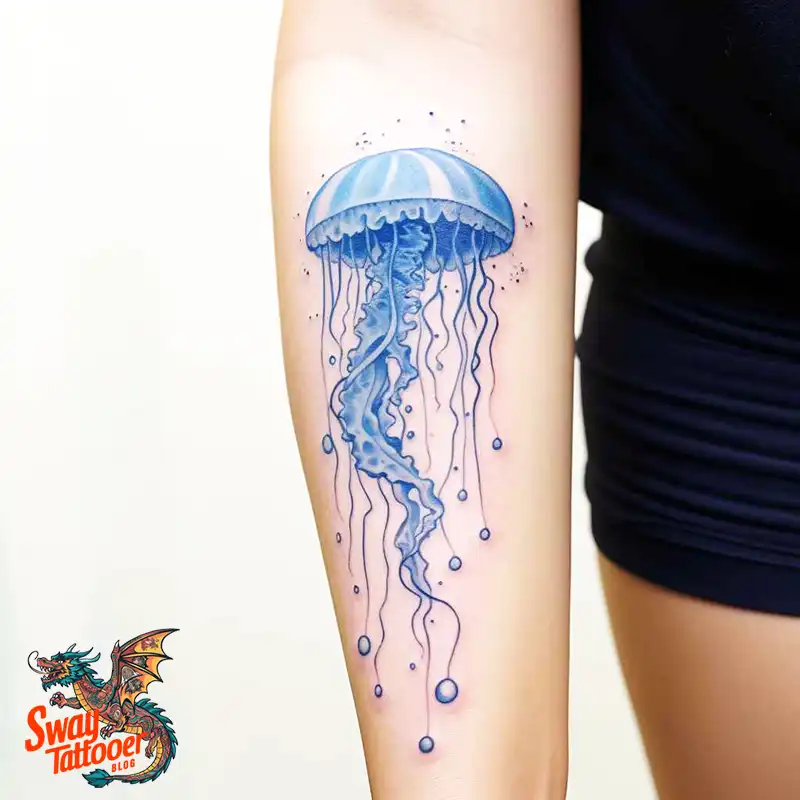
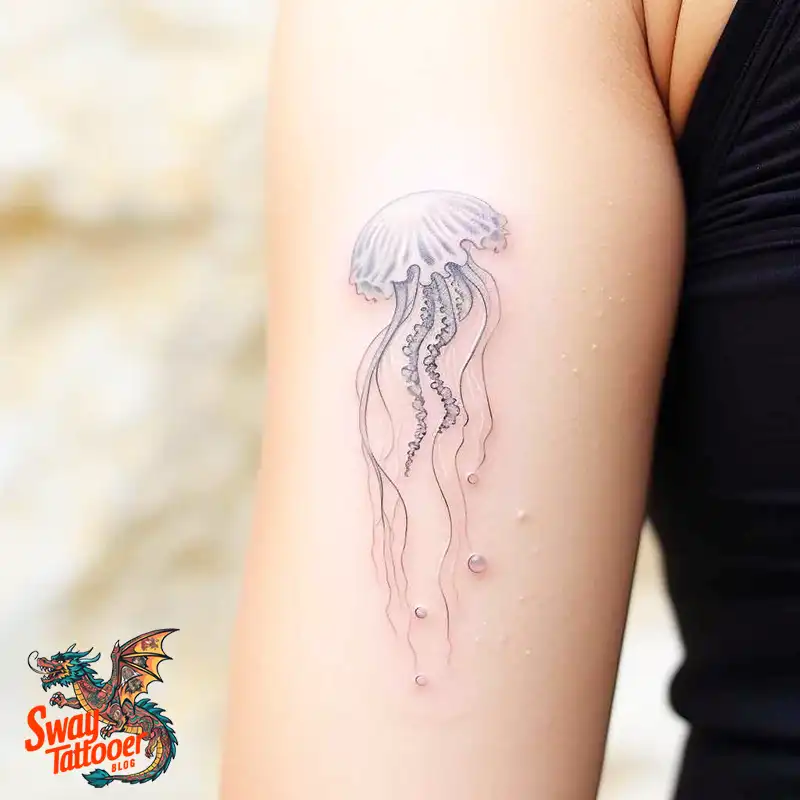
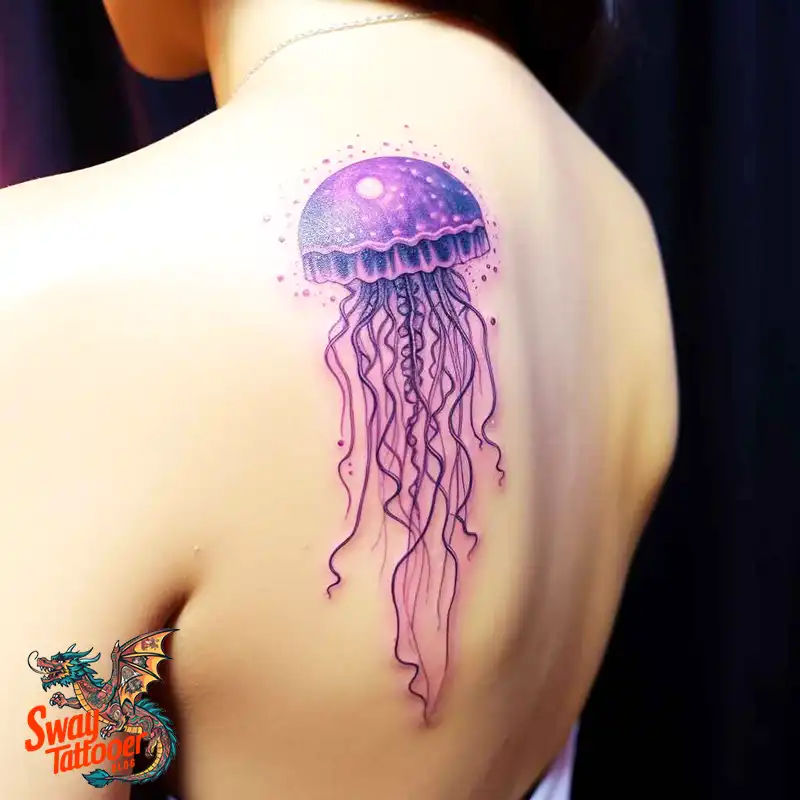
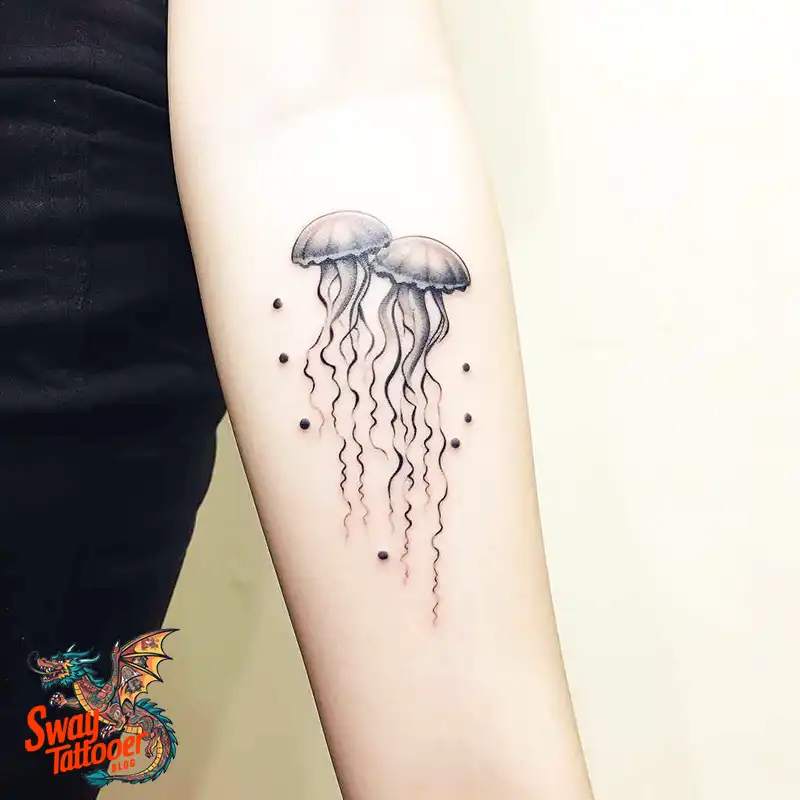
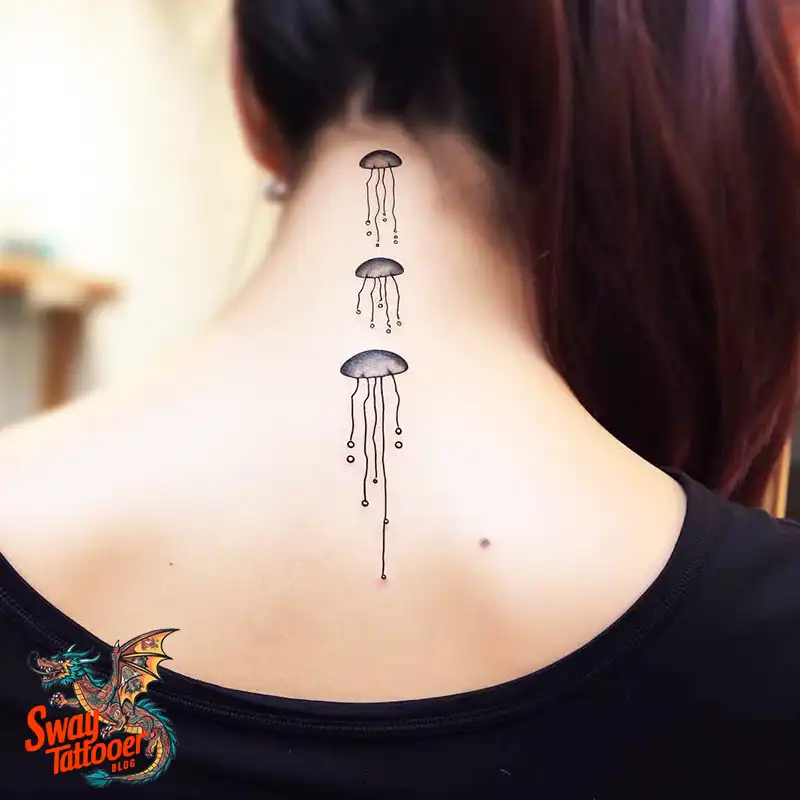
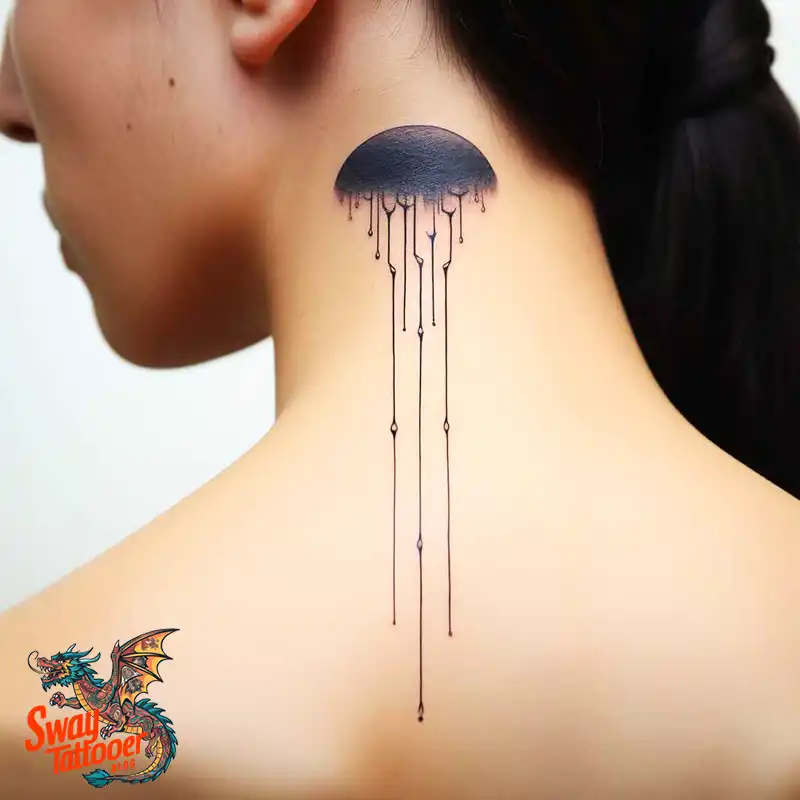
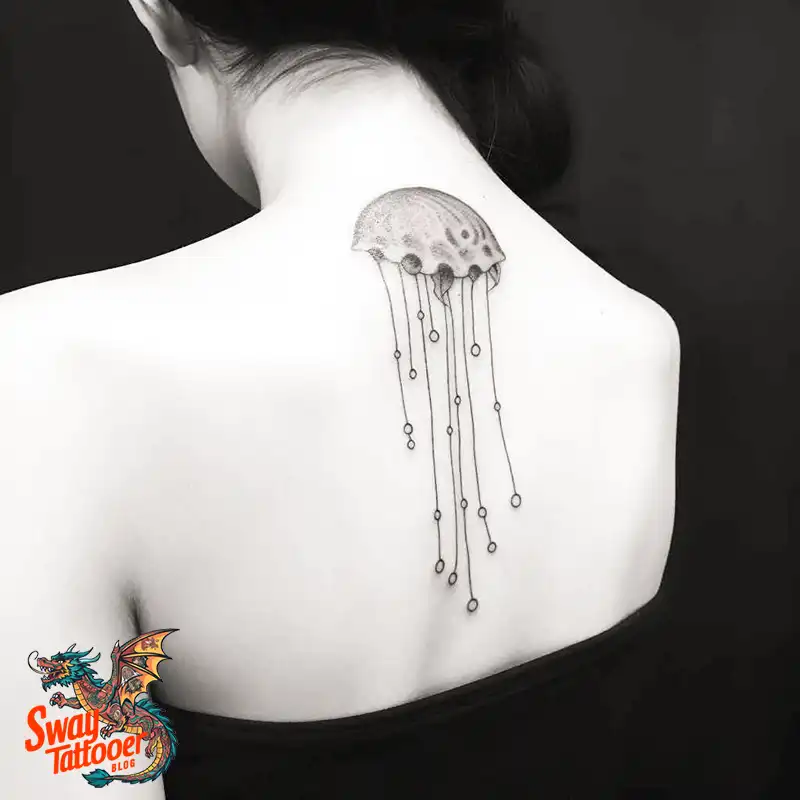
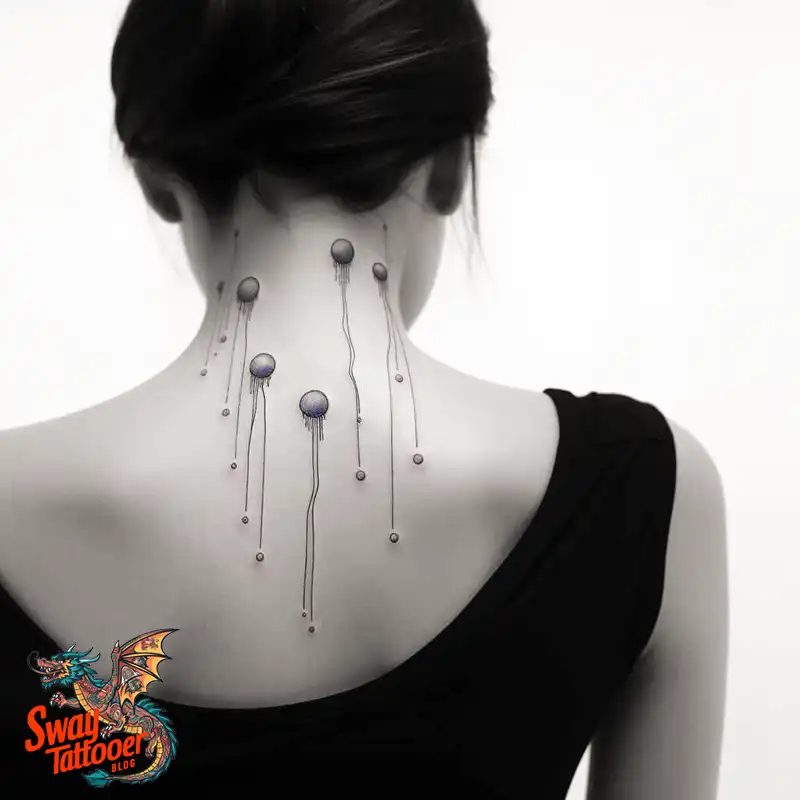
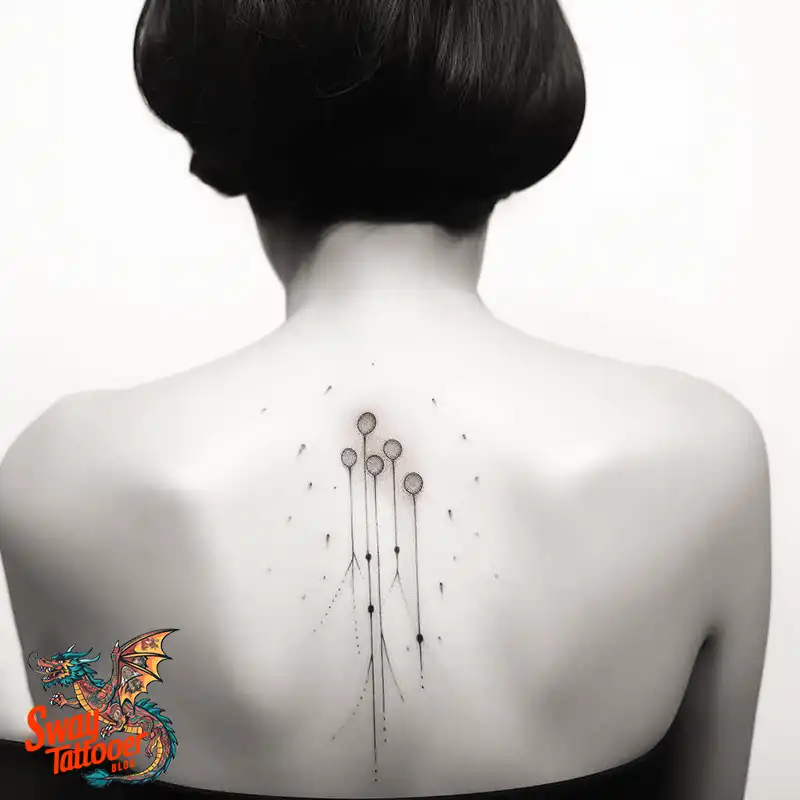
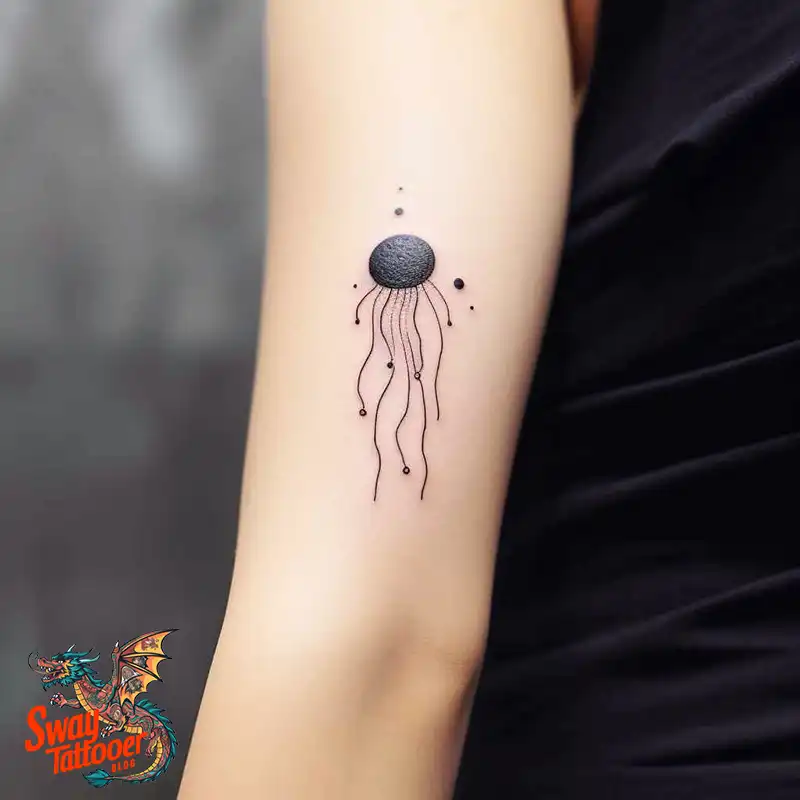
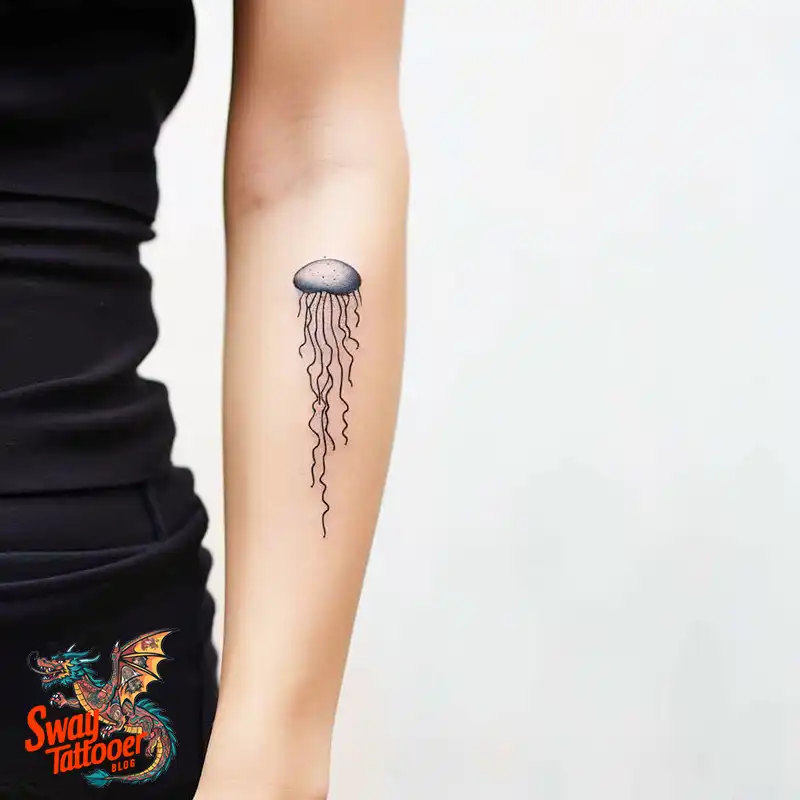
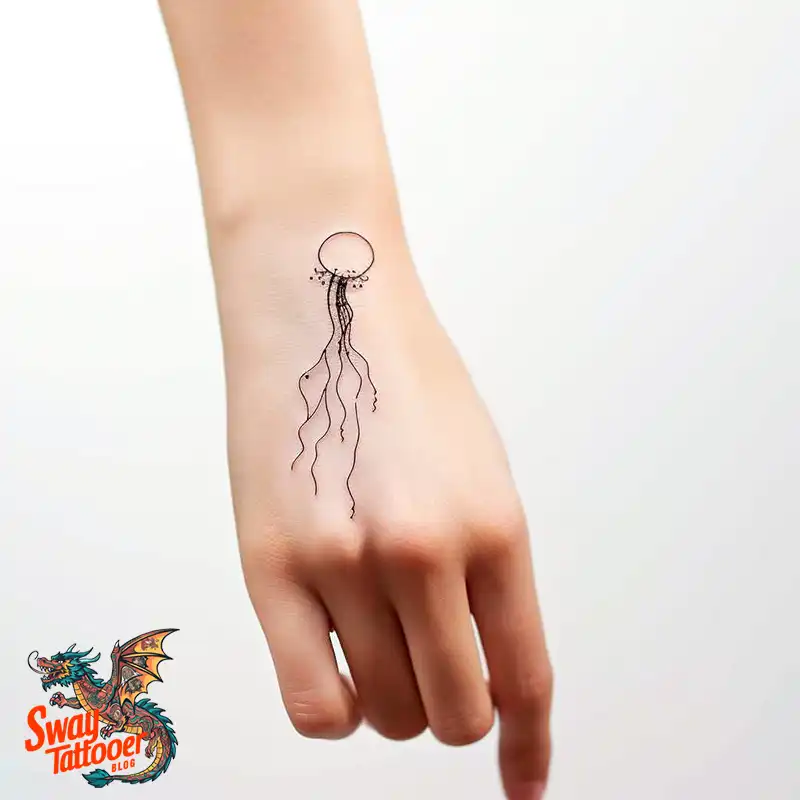
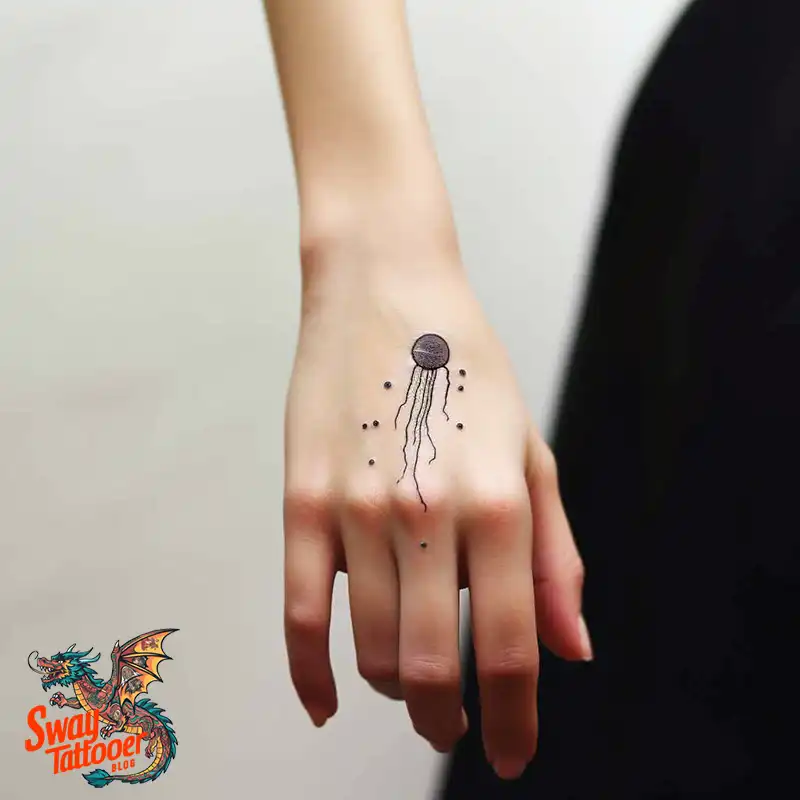
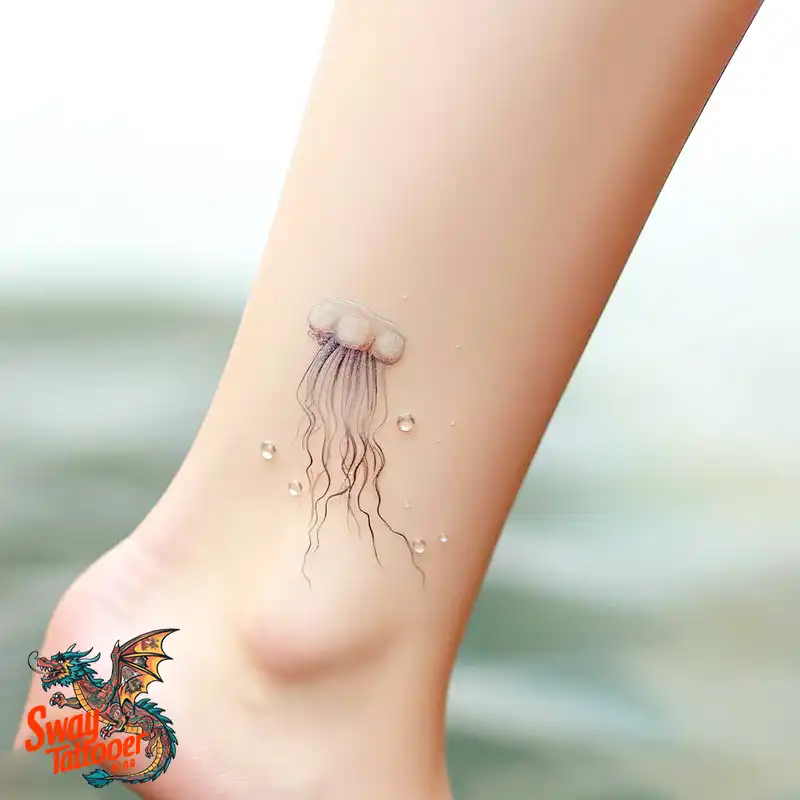
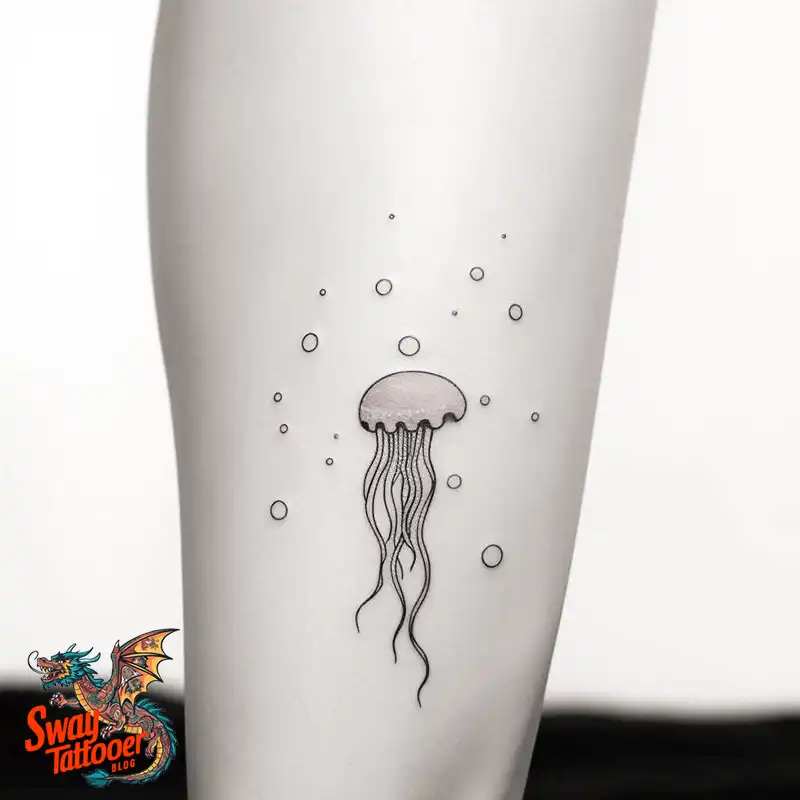
The Symbolism Behind Jellyfish Tattoos
Jellyfish are ancient and mysterious creatures that have traversed the oceans for millions of years. Their unique characteristics have led to a variety of symbolic meanings:
- Adaptability and Resilience: Jellyfish are remarkable in their ability to adapt to their surroundings. They can survive in various environments, from shallow coastal areas to the deep ocean. This adaptability can symbolize resilience and the ability to thrive in the face of adversity.
- Grace and Fluidity: The graceful, undulating movements of a jellyfish through the water are often associated with a sense of calm and fluidity. This can represent the ability to navigate life’s challenges with grace and ease.
- Mystery and Intrigue: With their translucent bodies and bioluminescent glow, jellyfish evoke a sense of mystery. They can symbolize the unknown, the enigmatic aspects of life, and the deep subconscious mind.
- Danger and Protection: While jellyfish appear delicate, their stings can be quite dangerous. This duality of beauty and danger can symbolize protection, the ability to defend oneself, and the balance between vulnerability and strength.
Design Styles for Jellyfish Tattoos
Jellyfish tattoos offer a wide range of artistic possibilities. Here are some popular design styles that can highlight the unique beauty of these creatures:
- Realistic: Realistic jellyfish tattoos capture the intricate details of the jellyfish, including their tentacles, bell, and subtle color gradients. This style can be stunning and lifelike, often requiring a skilled artist to bring the design to life.
- Watercolor: The watercolor style is perfect for jellyfish tattoos, as it mimics the fluidity and translucence of the jellyfish. This style uses soft, flowing colors and can create a dreamy, almost ethereal effect.
- Minimalist: For those who prefer a more understated design, minimalist jellyfish tattoos use simple lines and shapes to convey the essence of the jellyfish. These designs can be small and elegant, making them suitable for more discreet placements.
- Geometric: Geometric jellyfish tattoos incorporate shapes and patterns to create a modern and abstract interpretation of the jellyfish. This style can add a unique and contemporary twist to the traditional jellyfish design.
Placement Considerations for Jellyfish Tattoos
The placement of a jellyfish tattoo can significantly influence its impact and visibility. Here are some common considerations for placement:
- Arm: The arm is a versatile canvas for jellyfish tattoos. A design that wraps around the forearm or extends from the shoulder to the elbow can create a dynamic and flowing effect.
- Back: The back provides ample space for large and intricate jellyfish designs. A full-back jellyfish tattoo can be a breathtaking piece of art that showcases detailed work and vibrant colors.
- Leg: The leg, particularly the thigh or calf, is another excellent option for larger jellyfish tattoos. The vertical space allows for a design that mirrors the natural descent of a jellyfish in the water.
- Ribs: The ribcage offers a more intimate and personal placement for jellyfish tattoos. This area can be ideal for medium-sized designs that follow the natural contours of the body.
- Ankle or Wrist: For smaller, more delicate designs, the ankle or wrist can be perfect. These placements can highlight the minimalist or geometric styles and offer a subtle yet beautiful tattoo.
Care and Maintenance of Jellyfish Tattoos
Proper aftercare is essential to ensure that your jellyfish tattoo heals well and retains its vibrant colors and details. Here are some key tips for tattoo aftercare:
- Keep It Clean: Gently wash the tattoo with a mild, fragrance-free soap and lukewarm water. Avoid scrubbing, and pat the area dry with a clean towel.
- Moisturize: Apply a thin layer of a tattoo-specific ointment or a fragrance-free moisturizer to keep the skin hydrated. Avoid using products with alcohol or fragrances, as these can irritate the tattoo.
- Avoid Sun Exposure: Protect your tattoo from direct sunlight during the healing process. Once healed, always apply sunscreen to prevent fading and damage from UV rays.
- Stay Hydrated: Drinking plenty of water helps keep your skin hydrated and can aid in the healing process.
- Follow Your Artist’s Advice: Your tattoo artist will provide specific aftercare instructions based on their experience and the type of tattoo you have. Follow their guidance closely to ensure optimal healing.
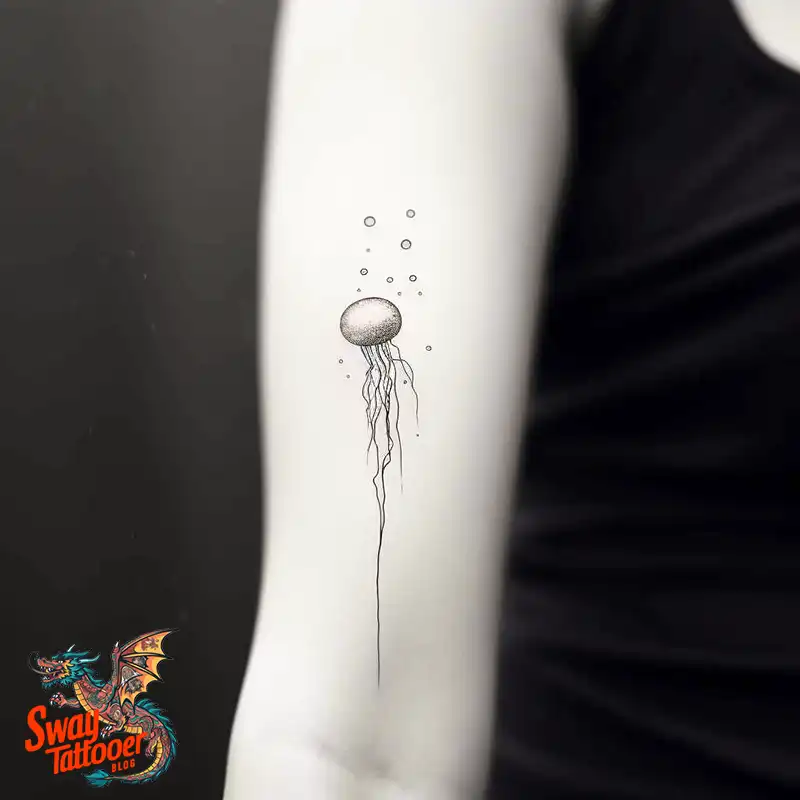
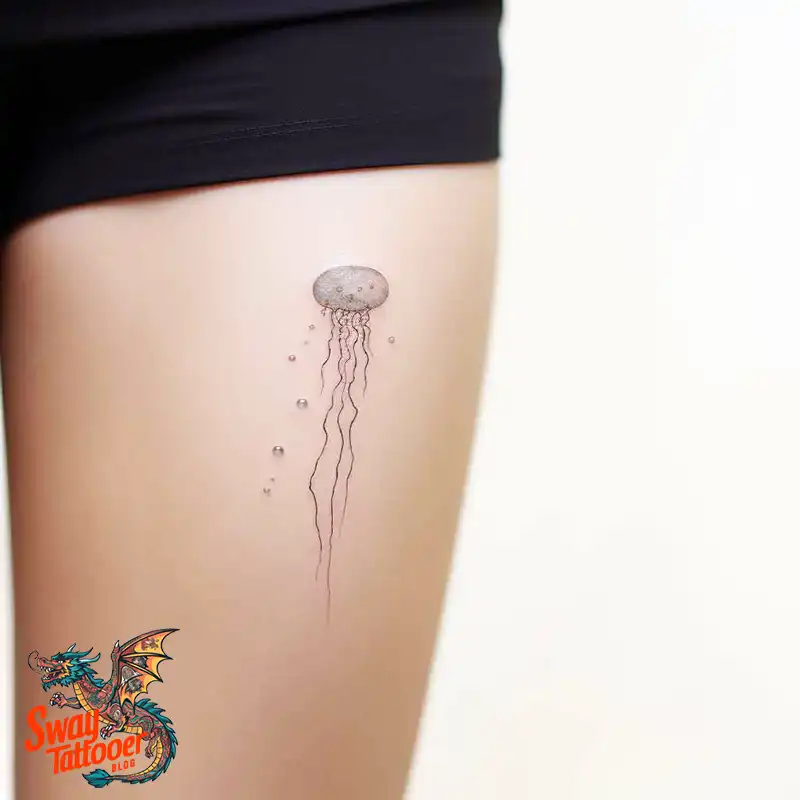
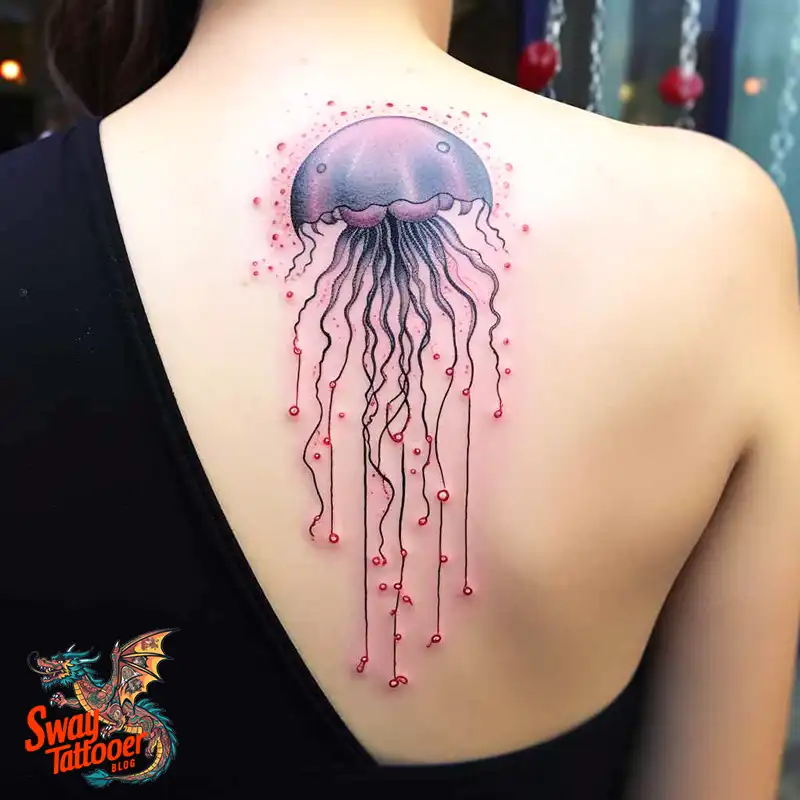
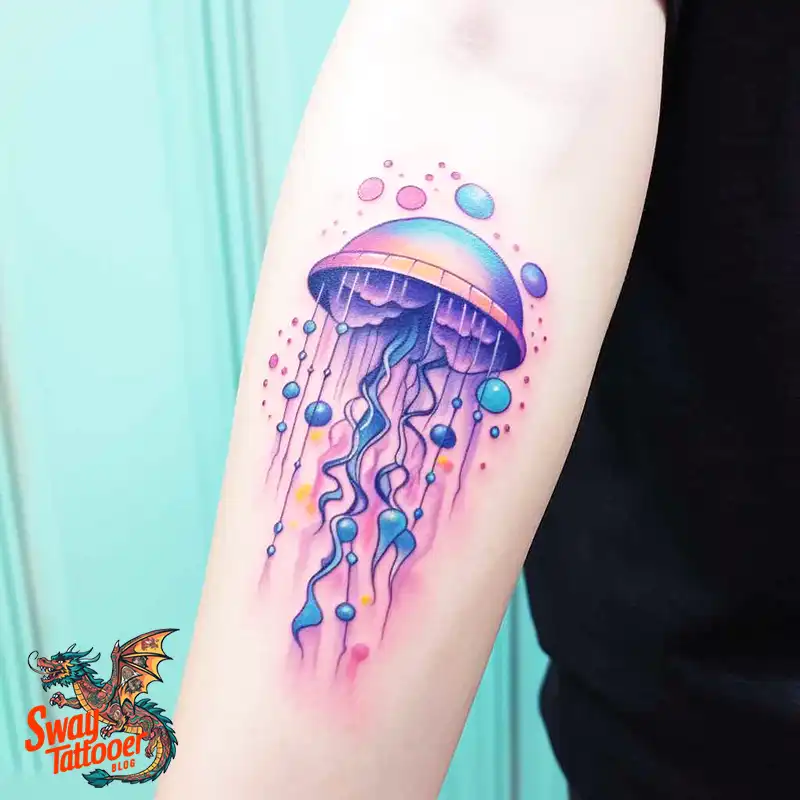
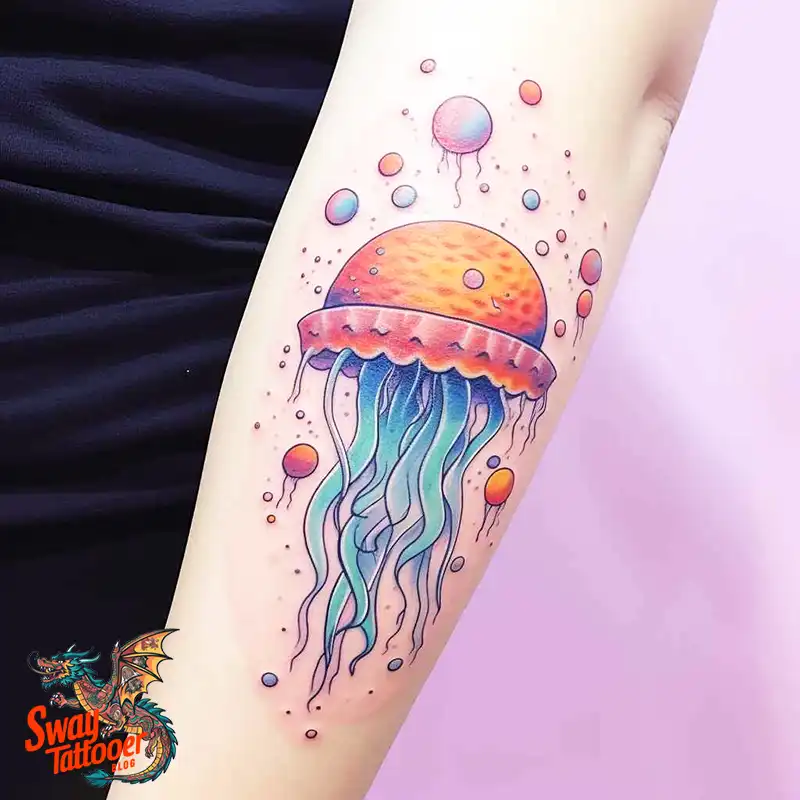
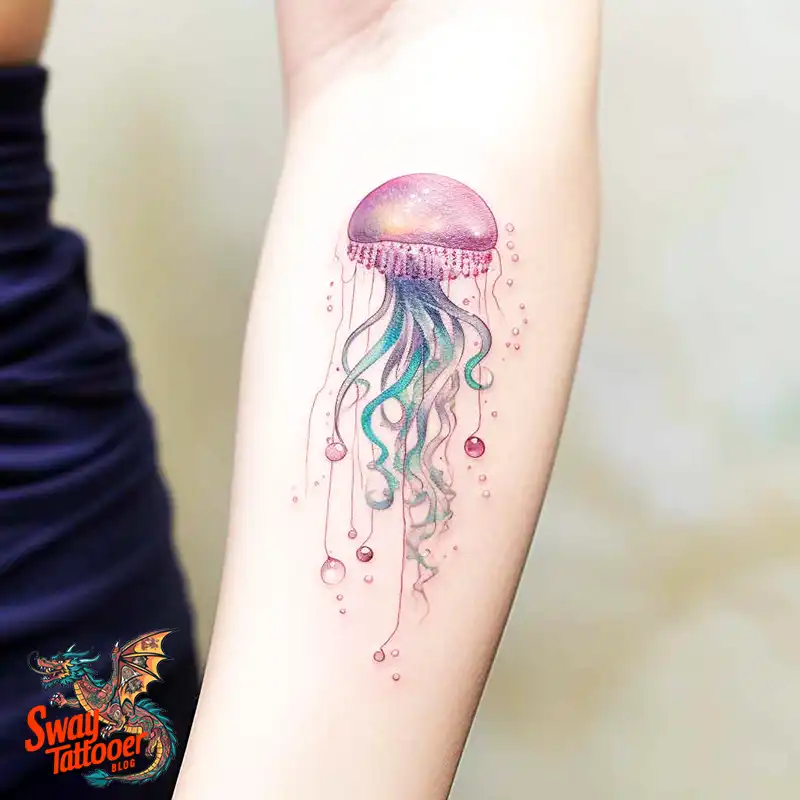
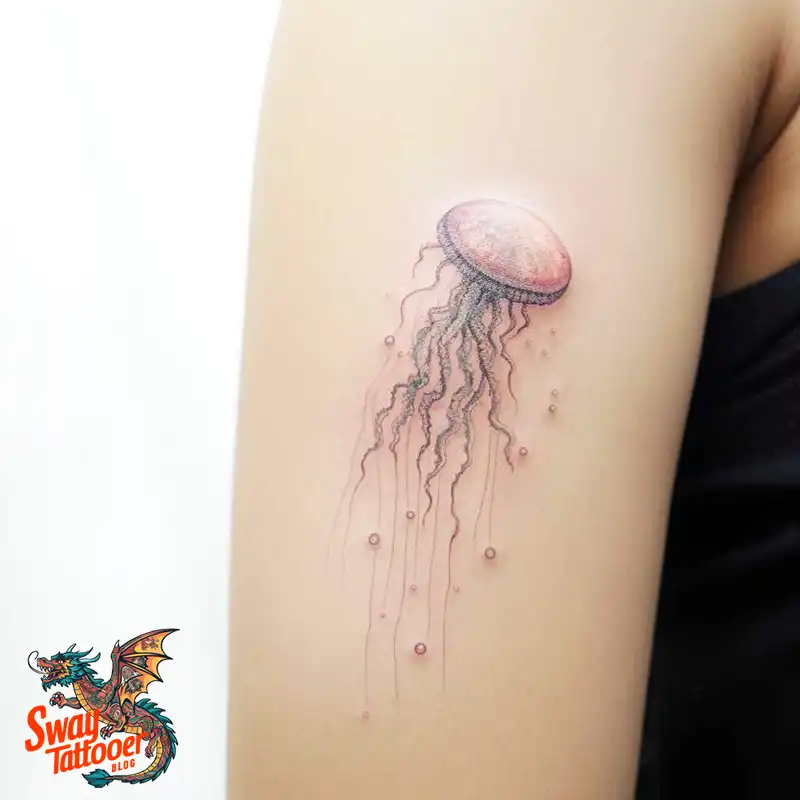
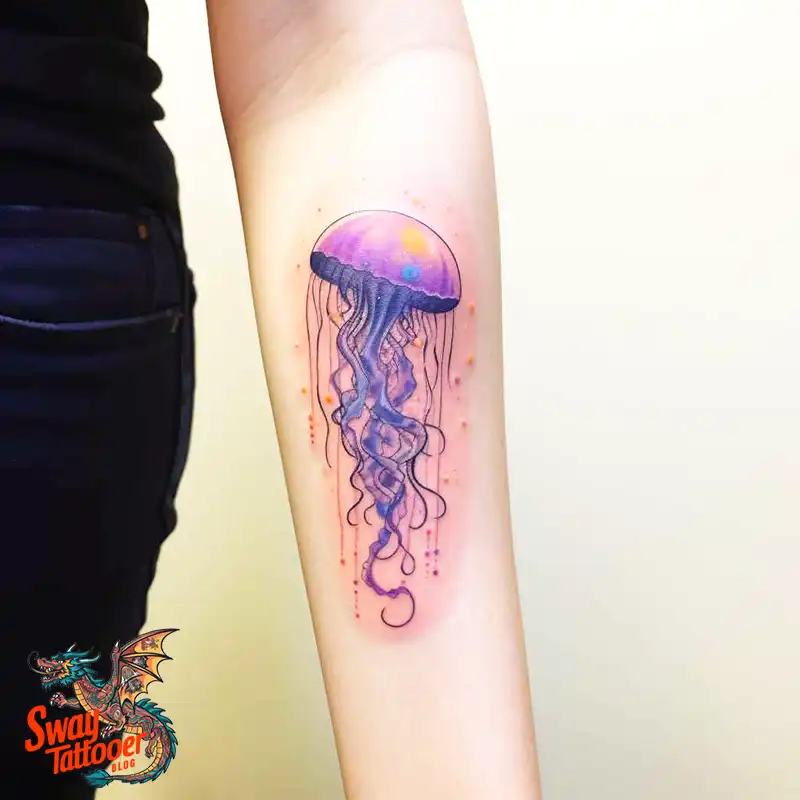
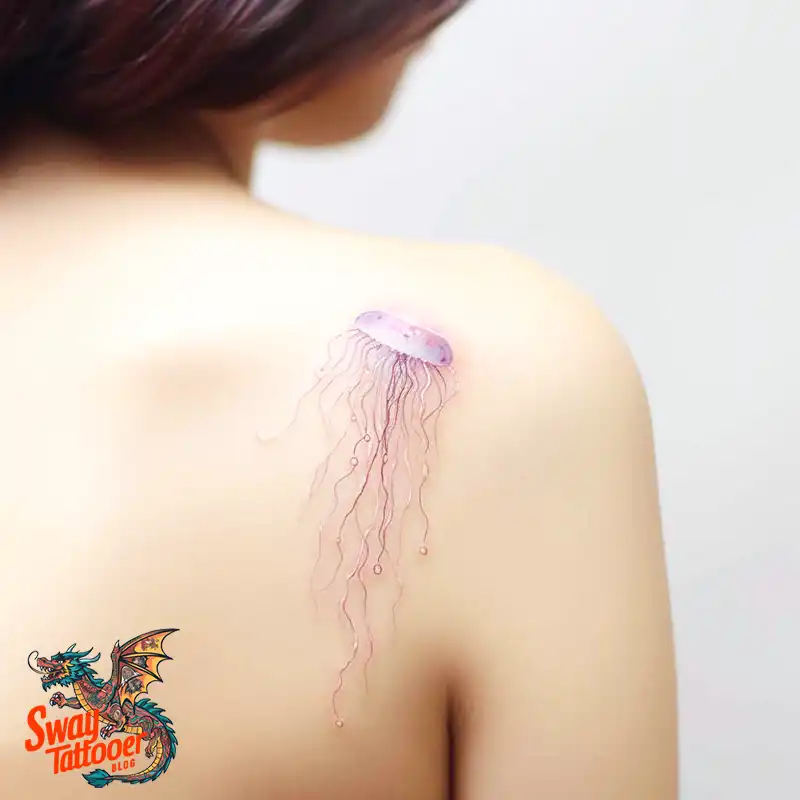
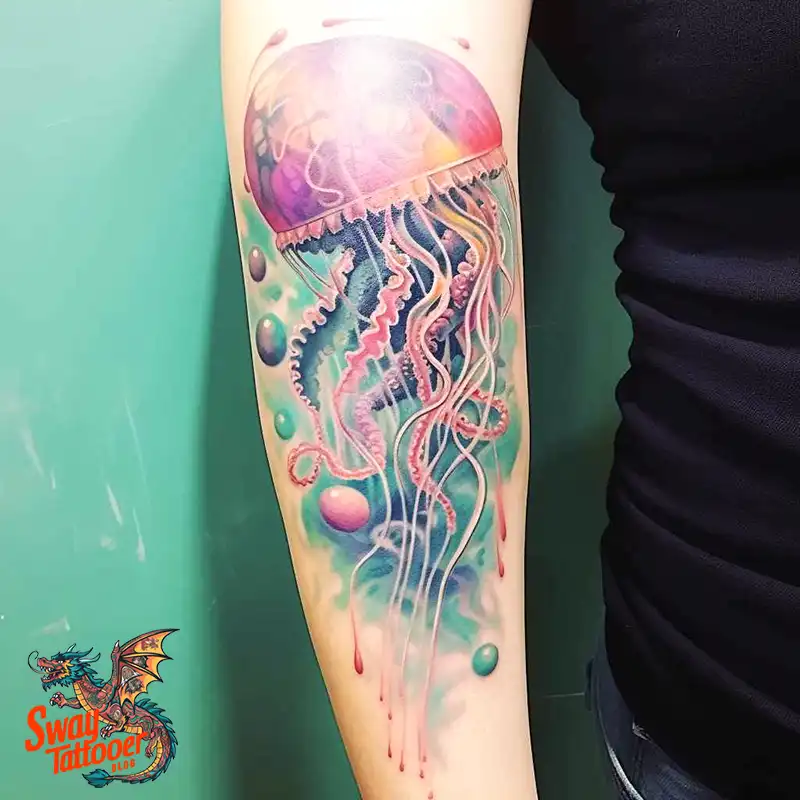
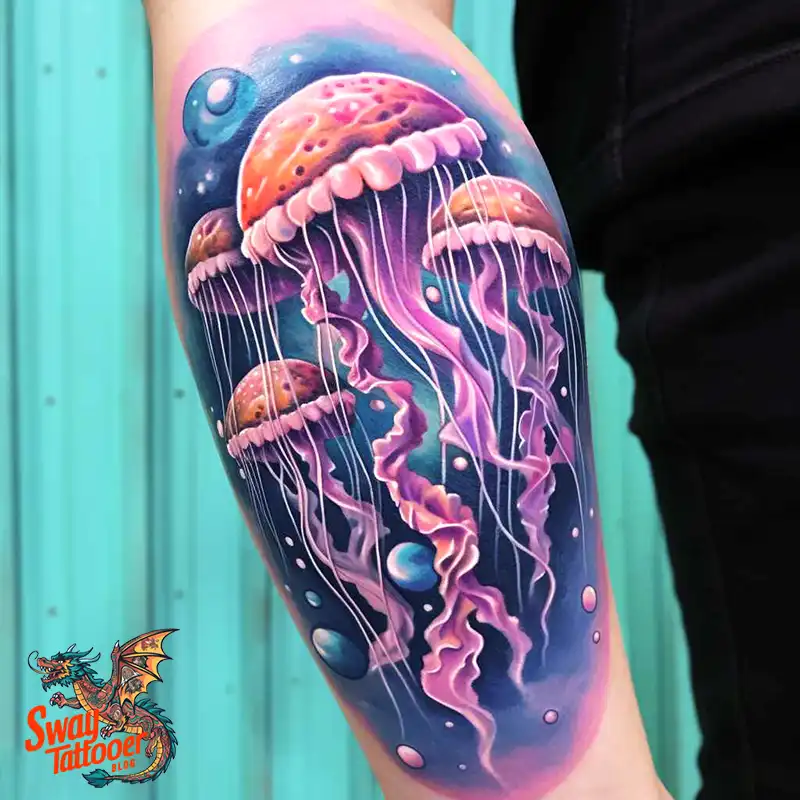
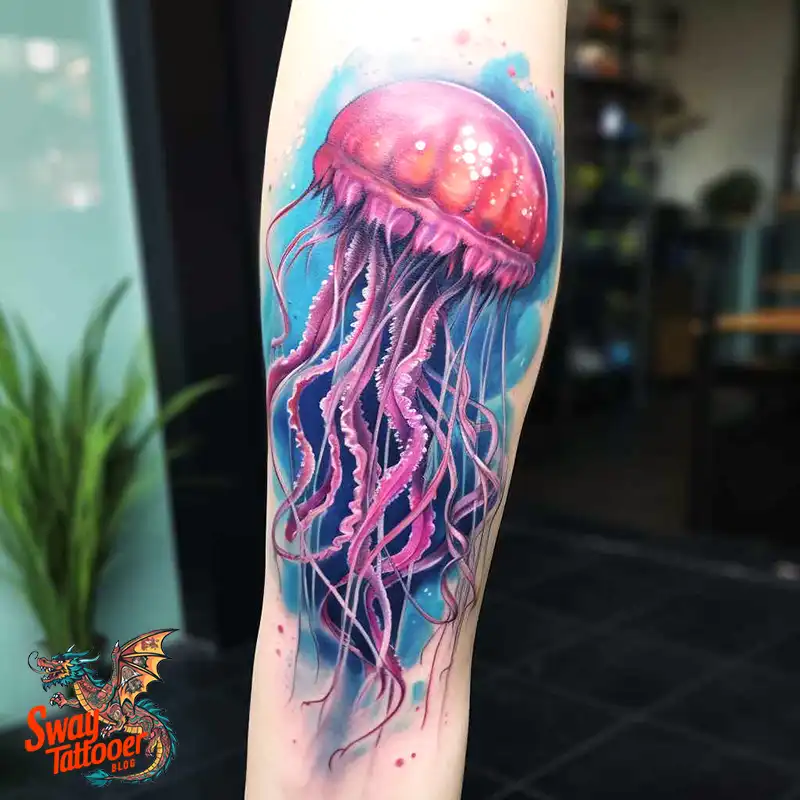
Different Types of Jellyfish Tattoos:
Jellyfish tattoos have surged in popularity due to their ethereal beauty, fluid motion, and profound symbolism. Let’s explore various types of jellyfish tattoos, their meanings, ideal placements, and essential aftercare tips to ensure your ink remains vibrant and healthy for years to come.
1. Traditional Jellyfish Tattoo
- Summary: Traditional jellyfish tattoos feature bold lines, vivid colors, and classic tattoo elements such as anchors or roses. These designs often highlight the jellyfish’s tentacles flowing gracefully around other nautical symbols.
- Relevance: The traditional style is timeless, blending the jellyfish’s natural elegance with a sense of nostalgia and maritime adventure.
- Best Placement: Upper arm, calf, or thigh, where there is ample space for intricate detailing.
2. Watercolor Jellyfish Tattoo
- Summary: Watercolor jellyfish tattoos mimic the fluidity of watercolor paintings, with soft, blended colors and minimal outlines. This style captures the surreal, dream-like essence of the jellyfish as it floats through the ocean.
- Relevance: The watercolor technique emphasizes the jellyfish’s otherworldly beauty and the fluid nature of water, symbolizing adaptability and emotional depth.
- Best Placement: Back, forearm, or shoulder blade, where the flow of color can be fully appreciated.
3. Geometric Jellyfish Tattoo
- Summary: Geometric jellyfish tattoos incorporate shapes like triangles, circles, and lines, creating a modern and abstract representation. These designs often feature a combination of geometric patterns and realistic elements.
- Relevance: Geometric tattoos symbolize balance, harmony, and the intersection of nature and modernity. The jellyfish’s natural curves contrast beautifully with sharp geometric shapes.
- Best Placement: Upper arm, chest, or side ribs, allowing room for complex designs and symmetry.
4. Black and Grey Jellyfish Tattoo
- Summary: Black and grey jellyfish tattoos use varying shades of black ink to create depth and shading, resulting in a striking, monochromatic image. This style can range from realistic to abstract interpretations.
- Relevance: The black and grey palette emphasizes the jellyfish’s intricate details and textures, symbolizing mystery and elegance.
- Best Placement: Sleeve, back, or leg, where the gradient shades can create a dramatic visual effect.
5. Minimalist Jellyfish Tattoo
- Summary: Minimalist jellyfish tattoos feature simple lines and basic shapes, capturing the essence of the jellyfish with a clean and understated design.
- Relevance: Minimalist tattoos are perfect for those who appreciate subtlety and simplicity. They often symbolize clarity, purity, and the beauty of uncomplicated forms.
- Best Placement: Wrist, ankle, or behind the ear, where the small, delicate design can be both discreet and meaningful.
Aftercare and Longevity of Your Jellyfish Tattoo
Aftercare Steps:
- Initial Healing:
- Keep it Clean: Wash the tattoo gently with lukewarm water and mild, fragrance-free soap. Pat dry with a clean towel.
- Moisturize: Apply a thin layer of fragrance-free, tattoo-specific ointment or unscented lotion to keep the skin hydrated.
- Protect: Cover the tattoo with a sterile bandage or plastic wrap as advised by your tattoo artist, usually for the first few hours to a day.
- Ongoing Care:
- Avoid Submersion: Do not submerge the tattoo in water (baths, pools, ocean) for at least two weeks.
- Avoid Sun Exposure: Protect the tattoo from direct sunlight. After healing, always use a high SPF sunscreen to prevent fading.
- Don’t Pick or Scratch: As the tattoo heals, it may scab or peel. Avoid picking or scratching to prevent infection and ensure proper healing.
Longevity Tips:
- Moisturize Regularly: Keep the tattooed skin hydrated even after it has healed. This helps maintain the vibrancy of the ink.
- Healthy Lifestyle: Maintain a healthy diet and stay hydrated. Smoking and excessive alcohol consumption can affect skin health and, consequently, the appearance of your tattoo.
- Touch-Ups: Over time, tattoos may fade due to exposure and skin regeneration. Regular touch-ups by a professional can help maintain the tattoo’s sharpness and color.
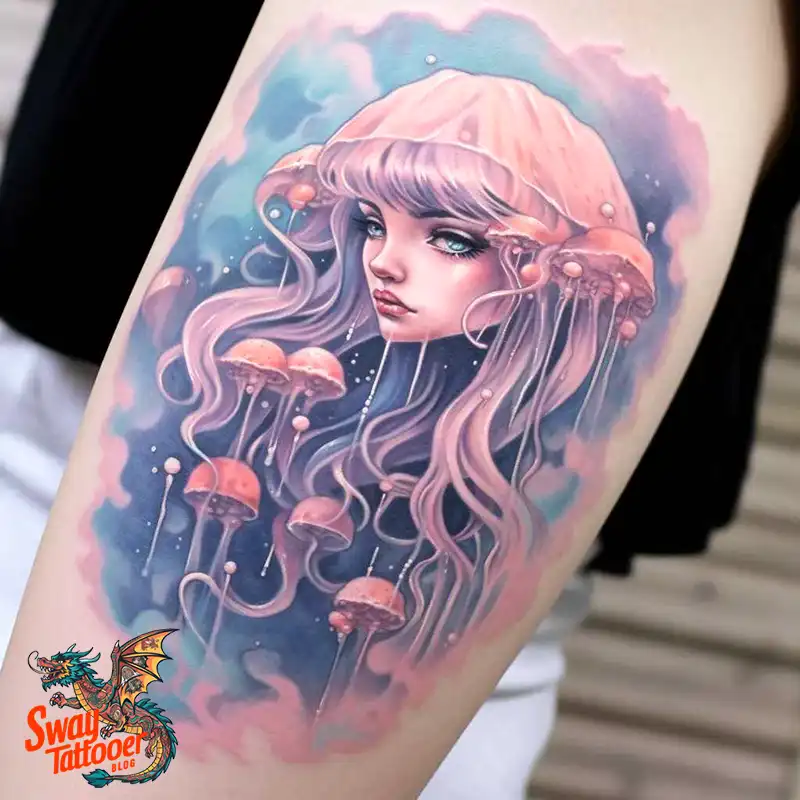
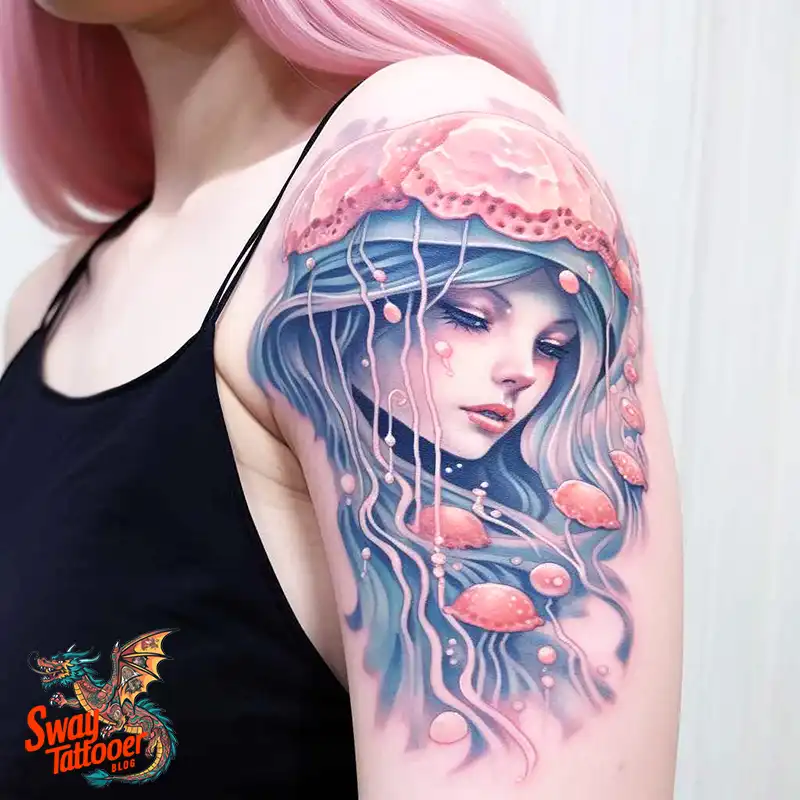
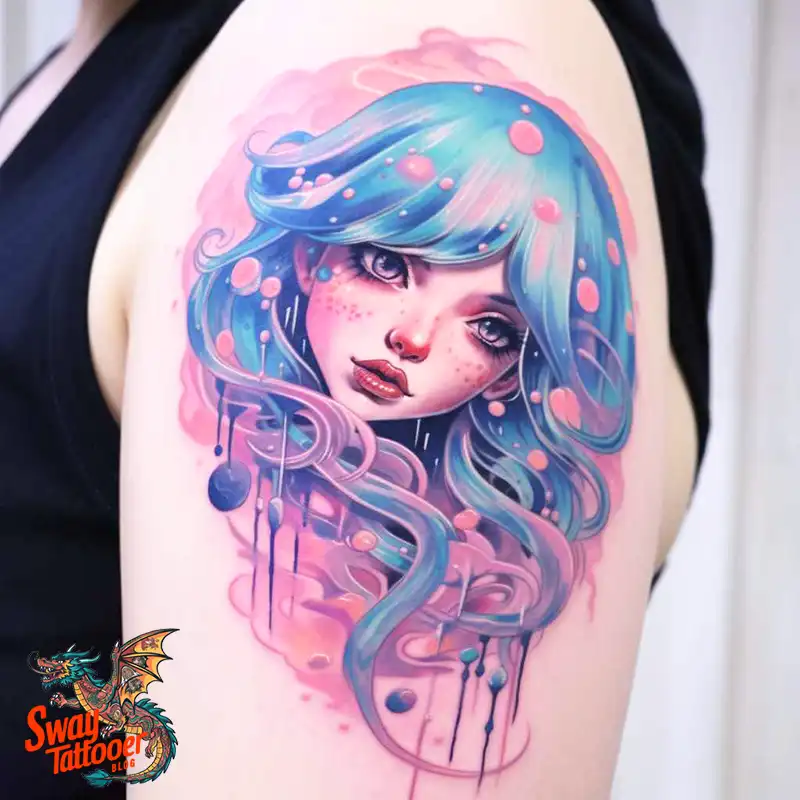
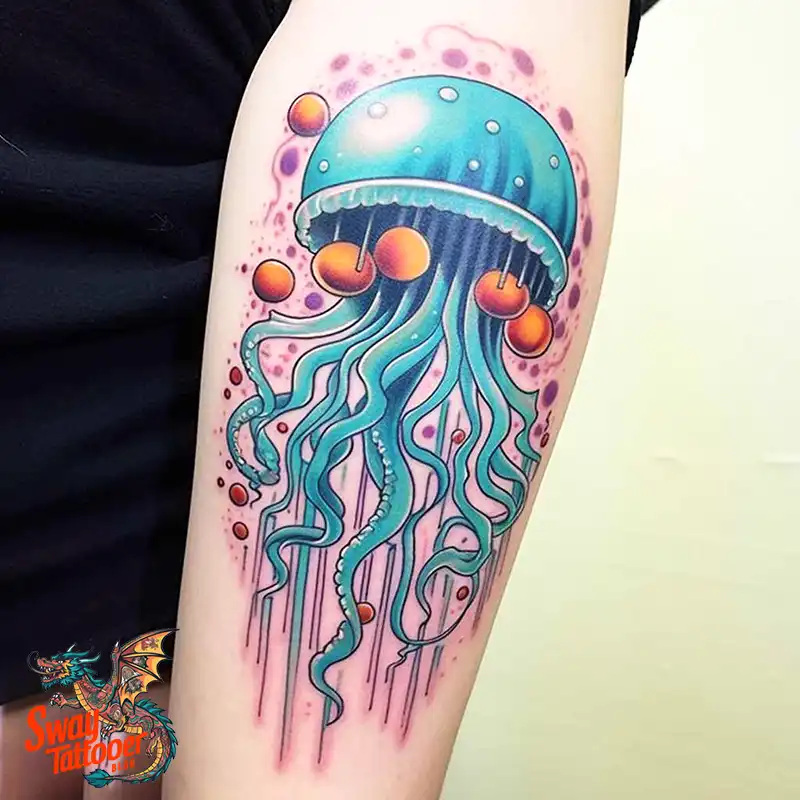
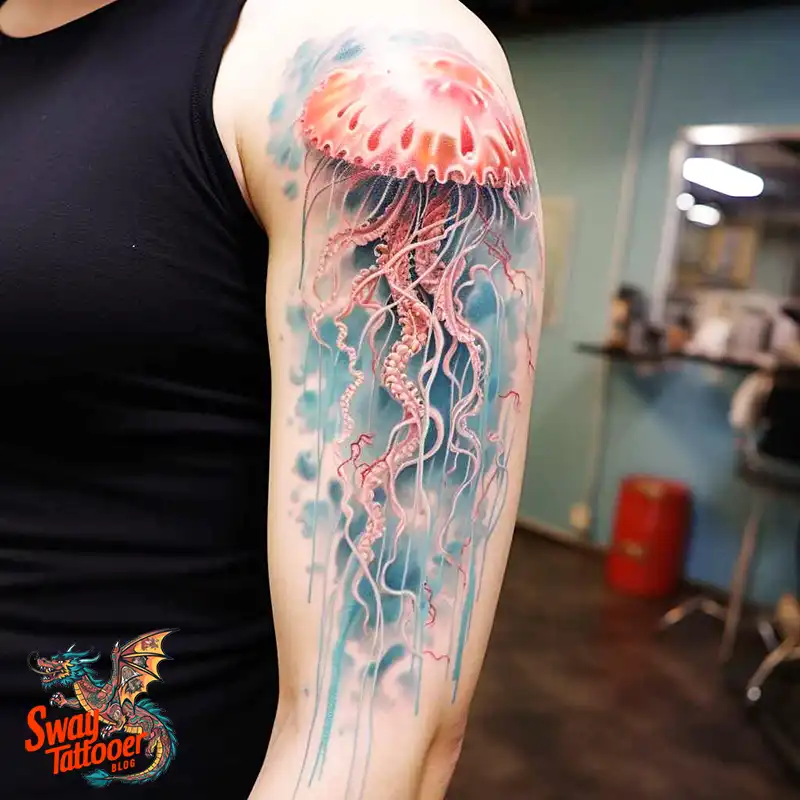
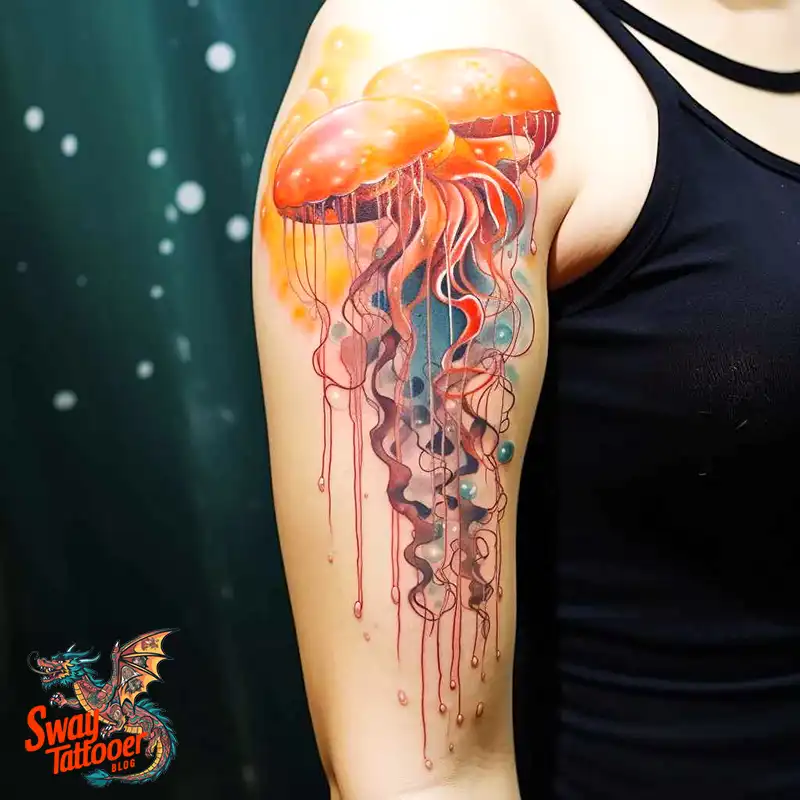
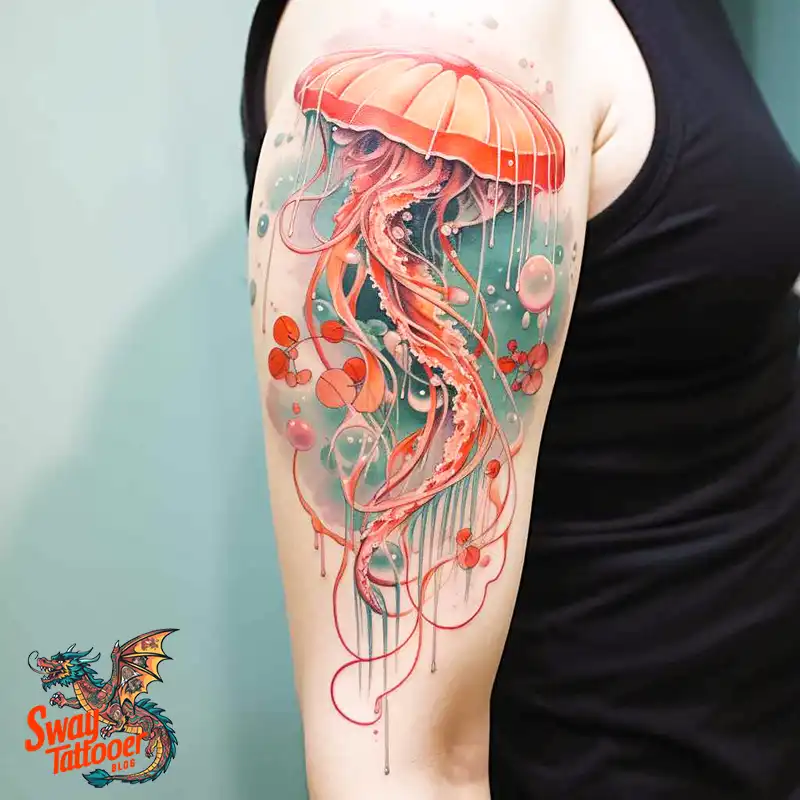
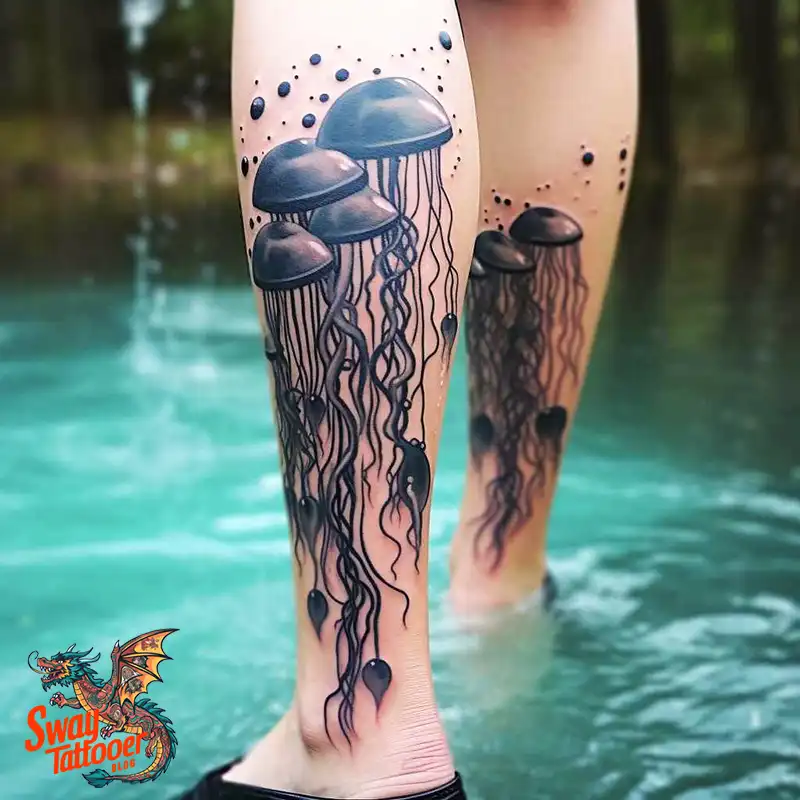
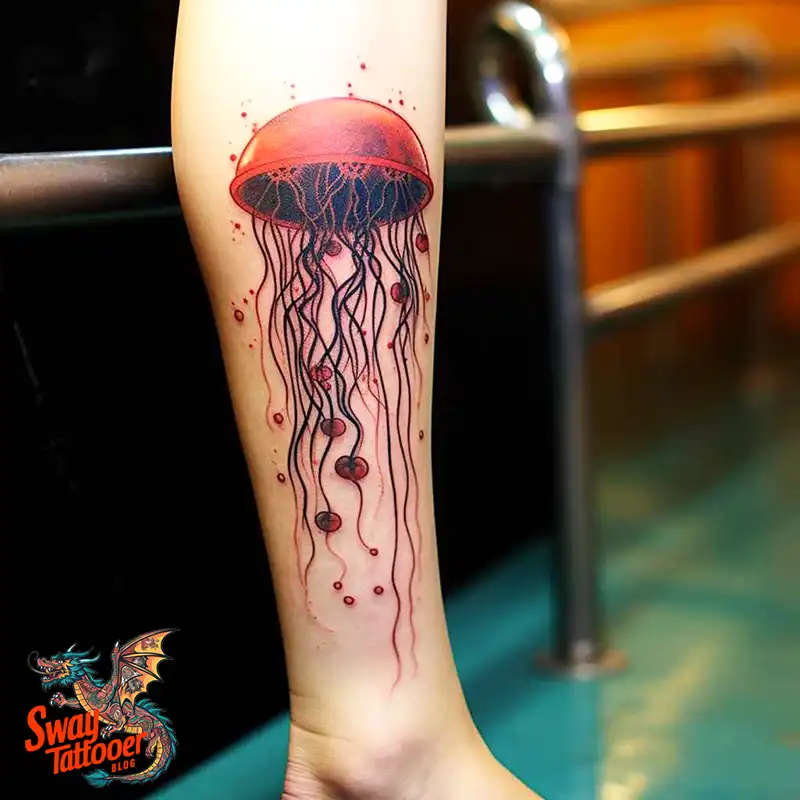
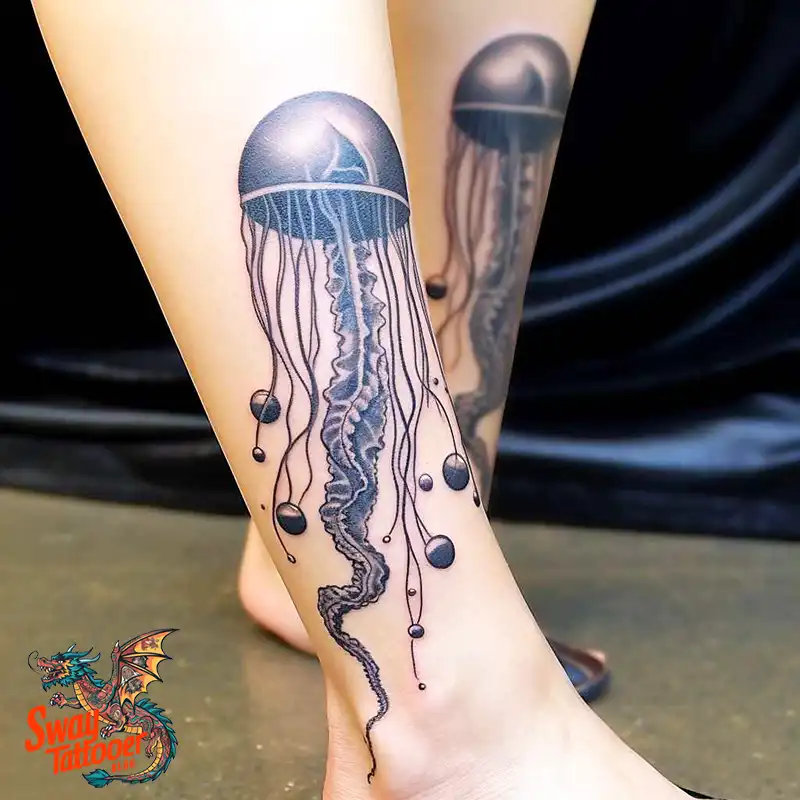
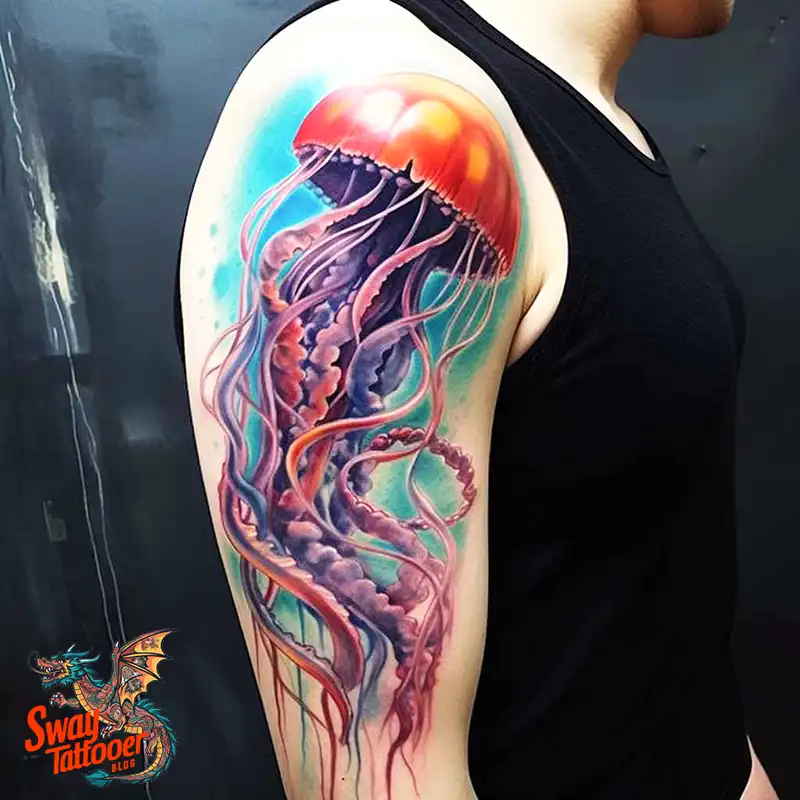




FAQs:
Frequently Asked Questions (FAQ) About Jellyfish Tattoos
1. What is the symbolism behind jellyfish tattoos?
Answer:
Jellyfish tattoos carry a variety of meanings that can resonate with different individuals in unique ways. Generally, they symbolize adaptability, survival, and resilience due to the jellyfish’s ability to thrive in the ever-changing oceanic environment. Their ethereal and graceful appearance also represents beauty, intuition, and tranquility. Some people are drawn to jellyfish tattoos because they embody a sense of mystery and depth, reflecting the enigmatic qualities of the ocean.
2. Where are the best placement options for a jellyfish tattoo?
Answer:
The placement of a jellyfish tattoo largely depends on the design’s size, complexity, and the individual’s personal preference. Common placement options include:
- Forearm or Upper Arm: Great for medium-sized designs and allows for easy visibility.
- Back: Provides a large canvas for intricate and expansive designs, making it ideal for those who want a detailed jellyfish tattoo.
- Thigh or Calf: Suitable for larger tattoos and can be shown or hidden as desired.
- Rib Cage: Offers a unique spot that complements the natural flow of jellyfish tentacles, though it is a more painful area to tattoo.
- Ankle or Wrist: Perfect for smaller, more delicate designs.
3. How painful is it to get a jellyfish tattoo?
Answer:
The pain level of getting a jellyfish tattoo varies based on the tattoo’s placement, the individual’s pain tolerance, and the tattoo’s complexity. Areas with more flesh, like the thigh or upper arm, tend to be less painful compared to bony regions like the ribs, ankles, or wrists. Additionally, larger and more detailed tattoos may involve more prolonged sessions, potentially increasing discomfort. It’s important to discuss pain management with your tattoo artist and to take breaks during longer sessions if necessary.
4. What styles are popular for jellyfish tattoos?
Answer:
Jellyfish tattoos can be rendered in a variety of styles, each offering a different aesthetic and emotional impact. Some popular styles include:
- Realism: Highly detailed, lifelike depictions that capture the jellyfish’s natural beauty and intricate details.
- Watercolor: Uses vibrant colors and fluid brushstrokes to create a dreamy, almost surreal look.
- Line Art: Focuses on clean, minimalistic lines that can be both elegant and modern.
- Traditional: Bold lines and bright, solid colors that give a classic tattoo vibe.
- Neo-Traditional: Combines traditional elements with more modern details and shading techniques, offering a rich, textured appearance.
5. How do I care for my jellyfish tattoo after getting it?
Answer:
Proper aftercare is crucial for ensuring your jellyfish tattoo heals well and retains its vibrancy. Follow these steps:
- Keep it clean: Gently wash the tattooed area with mild, fragrance-free soap and lukewarm water. Pat it dry with a clean towel.
- Apply ointment: Use a thin layer of a tattoo-specific ointment or a fragrance-free moisturizer to keep the skin hydrated.
- Avoid sun exposure: Protect your tattoo from direct sunlight, as UV rays can cause fading and irritation. Once healed, apply sunscreen regularly.
- Avoid soaking: Refrain from swimming, hot tubs, and baths until your tattoo is fully healed, as submerging it can introduce bacteria and cause infection.
- Wear loose clothing: Choose breathable, loose-fitting clothes to avoid friction and allow your tattoo to breathe.
- Follow your artist’s advice: Always adhere to the specific aftercare instructions provided by your tattoo artist, as they may have personalized recommendations based on your tattoo’s characteristics.
By following these guidelines, you can ensure your jellyfish tattoo heals properly and remains a stunning piece of art on your body.
Conclusion
Jellyfish tattoos are very popular because they mix beauty, mystery, and strength. In this post, we learned that jellyfish can mean flexibility, calm, and moving through life smoothly. We looked at many art styles, from realistic designs to bright, abstract ones.
We also talked about the best places on your body for a jellyfish tattoo and why it’s important to choose the right spot. Whether you want a small jellyfish or a big, detailed one, these tattoos let you show off your own style. We even mentioned how important it is to pick a good tattoo artist and follow the right care steps so your tattoo stays great.
In the end, a jellyfish tattoo is not just beautiful to look at—it also represents your personal journey and inner strength. It reminds us that change can be beautiful and that we can move gracefully through life’s ups and downs. If you love the ocean and its magic, a jellyfish tattoo might be the perfect way to tell your unique story.


Leave a Reply